Mechano-Chemical Properties of Electron Beam Irradiated Polyetheretherketone
Abstract
:1. Introduction
2. Materials and Methods
2.1. Electron Irradiation
2.2. SPM
2.3. Nanoindentation
2.4. Brillouin Spectroscopy and FTIR
3. Results
3.1. Assessment of Electron Penetration Depth
3.2. Nanoindentation
3.3. Brillouin Specrtoscopy
3.4. FTIR
4. Discussion
5. Conclusions
Author Contributions
Funding
Data Availability Statement
Acknowledgments
Conflicts of Interest
References
- May, R. Polyetheretherketones. In Encyclopedia of Polymer Science and Technology; John Wiley & Sons Inc.: Hoboken, NJ, USA, 2002. [Google Scholar]
- Hegazy, E.S.A.; Sasuga, T.; Nishii, M.; Seguchi, T. Irradiation effects on aromatic polymers: 2. Gas evolution during electron-beam irradiation. Polymer 1992, 33, 2904–2910. [Google Scholar] [CrossRef]
- Kurtz, S.M. Chapter 6—Chemical and Radiation Stability of PEEK. In Plastics Design Library, PEEK Biomaterials Handbook; Kurtz, S.M., Ed.; William Andrew Publishing: Norwich, NY, USA, 2012; pp. 75–79. ISBN 9781437744637. [Google Scholar]
- Harding, M.J.; Brady, S.; O’Connor, H.; Lopez-Rodriguez, R.; Edwards, M.D.; Tracy, S.; Dowling, D.; Gibson, G.; Girard, K.P.; Ferguson, S. 3D printing of PEEK reactors for flow chemistry and continuous chemical processing. React. Chem. Eng. 2020, 5, 728–735. [Google Scholar] [CrossRef]
- Searle, O.B.; Pfeiffer, R.H. Victrex® poly (ethersulfone)(PES) and Victrex® poly (etheretherketone)(PEEK). Polym. Eng. Sci. 1985, 25, 474–476. [Google Scholar] [CrossRef]
- Shekar, R.I.; Kotresh, T.M.; Rao, P.D.; Kumar, K. Properties of high modulus PEEK yarns for aerospace applications. J. Appl. Polym. Sci. 2009, 112, 2497–2510. [Google Scholar] [CrossRef]
- Chinthavali, M. 3D printing technology for automotive applications. In Proceedings of the 2016 International Symposium on 3D Power Electronics Integration and Manufacturing (3D-PEIM), Raleigh, NC, USA, 13–15 June 2016; pp. 1–13. [Google Scholar]
- Page, J.Y.S.D.; Bonon, H.W.; Bui, V.T. Neutron and gamma radiation effects on the viscoelastic behavior of poly (aryl ether ether ketone). In Proceedings of the Powering Canada’s Future, Toronto, ON, Canada, 8–11 June 1997. [Google Scholar]
- Bonin, H.W.; Vui, V.T.; Legault, J.F. High polymer composites for containers for the long-term storage of spent nuclear fuel and high level radioactive waste. In Proceedings of the Powering Canada’s Future, Toronto, ON, Canada, 8–11 June 1997. [Google Scholar]
- Kumar, R.; Singh, R. Thermoplastic Containers for Disposal of Radioactive Waste. In Reference Module in Materials Science and Materials Engineering; Elsevier: Amsterdam, The Netherlands, 2020. [Google Scholar]
- Siewert, B.; Plaza-Castro, M.; Sereno, N.; Jarman-Smith, M. Applications of PEEK in the dental field. In PEEK Biomaterials Handbook; William Andrew Publishing: Norwich, NY, USA, 2019; pp. 333–342. [Google Scholar]
- Kurtz, S.M.; Lanman, T. Dynamic stabilization and semirigid PEEK rods for spinal fusion. In PEEK Biomaterials Handbook; William Andrew Publishing: Norwich, NY, USA, 2019; pp. 281–289. [Google Scholar]
- Huang, T.; Song, J.; He, H.; Zhang, Y.B.; Li, X.M.; He, T. Impact of SPEEK on PEEK membranes: Demixing, morphology and performance enhancement in lithium membrane extraction. J. Membr. Sci. 2020, 615, 118448. [Google Scholar] [CrossRef]
- Li, D.; Shi, D.; Feng, K.; Li, X.; Zhang, H. Poly (ether ether ketone) (PEEK) porous membranes with super high thermal stability and high rate capability for lithium-ion batteries. J. Membr. Sci. 2017, 530, 125–131. [Google Scholar] [CrossRef]
- Tahir, Z.; Ilyas, A.; Li, X.; Bilad, M.R.; Vankelecom, I.F.; Khan, A.L. Tuning the gas separation performance of fluorinated and sulfonated PEEK membranes by incorporation of zeolite 4A. J. Appl. Polym. Sci. 2018, 135, 45952. [Google Scholar] [CrossRef]
- da Silva Burgal, J.; Peeva, L.; Livingston, A. Towards improved membrane production: Using low-toxicity solvents for the preparation of PEEK nanofiltration membranes. Green Chem. 2016, 18, 2374–2384. [Google Scholar] [CrossRef] [Green Version]
- Manas, D.; Manas, M.; Mizera, A.; Navratil, J.; Ovsik, M.; Tomanova, K.; Sehnalek, S. Use of irradiated polymers after their lifetime period. Polymers 2018, 10, 641. [Google Scholar] [CrossRef] [Green Version]
- Tavlet, M.; Van der Burgt, H. Radiation Resistance and Other Safety Aspects of High-Performance Plastics by ERTA; No. CERN-TIS-94-13; CERN: Meyrin, Switzerland, 1994. [Google Scholar]
- Sasuga, T.; Kudoh, H. Ion irradiation effects on thermal and mechanical properties of poly (ether–ether–ketone)(PEEK). Polymer 2000, 41, 185–194. [Google Scholar] [CrossRef]
- Rao, G.R.; Lee, E.H. Effects of sequential He+ and Ar+ implantation on surface properties of polymers. J. Mater. Res. 1996, 11, 2661–2667. [Google Scholar] [CrossRef]
- Nakamura, H.; Nakamura, T.; Noguchi, T.; Imagawa, K. Photodegradation of PEEK sheets under tensile stress. Polym. Degrad. Stab. 2006, 91, 740–746. [Google Scholar] [CrossRef] [Green Version]
- Kornacka, E.M.; Przybytniak, G.; Nowicki, A. Radical processes initiated by ionizing radiation in PEEK and their macroscopic consequences. Polym. Adv. Technol. 2019, 30, 79–85. [Google Scholar] [CrossRef] [Green Version]
- Woo, L.; Sandford, C.L. Comparison of electron beam irradiation with gamma processing for medical packaging materials. Radiat. Phys. Chem. 2002, 63, 845–850. [Google Scholar] [CrossRef]
- El-Saftawy, A.A.; Elfalaky, A.; Ragheb, M.S.; Zakhary, S.G. Electron beam induced surface modifications of PET film. Radiat. Phys. Chem. 2014, 102, 96–102. [Google Scholar] [CrossRef]
- Rahman, M.S.; Shaislamov, U.; Yang, J.; Kim, J.; Yu, Y.H.; Choi, S.; Lee, H. Effects of electron beam irradiation on tribological and physico-chemical properties of Polyoxymethylene copolymer (POM-C). Nucl. Instrum. Methods Phys. Res. B 2016, 387, 54–62. [Google Scholar] [CrossRef]
- Ovsik, M.; Manas, M.; Stanek, M.; Dockal, A.; Mizera, A.; Fluxa, P.; Bednarik, M. Adamek, M. Nano-Mechanical Properties of Surface Layers of Polyethylene Modified by Irradiation. Materials 2020, 13, 929. [Google Scholar] [CrossRef] [Green Version]
- Li, H.; Yang, J.; Lv, G.; Dong, S.; Tian, F.; Dong, S.; Li, X. In-Situ saxs/waxd analysis on structural evolution in peek irradiated by 1 MeV electrons during tensile deformation. Polym. Degrad. Stab. 2020, 181, 109350. [Google Scholar] [CrossRef]
- Rival, G.; Dantras, E.; Paulmier, T. Electronic irradiation ageing in the vicinity of glass transition temperature for PEEK space applications. Polym. Degrad. Stab. 2020, 181, 109305. [Google Scholar] [CrossRef]
- Steelman, Z.A.; Weems, A.C.; Traverso, A.J.; Szafron, J.M.; Maitland, D.J.; Yakovlev, V.V. Revealing the glass transition in shape memory polymers using Brillouin spectroscopy. Appl. Phys. Lett. 2017, 111, 241904. [Google Scholar] [CrossRef]
- Auslender, V.L. ILU-type electron accelerators for industrial technologies. Nucl. Instrum. Methods Phys. Res. Sect. B Beam Interact. Mater. At. 1994, 89, 46–48. [Google Scholar] [CrossRef]
- Oliver, W.C.; Pharr, G.M. Measurement of hardness and elastic modulus by instrumented indentation: Advances in understanding and refinements to methodology. J. Mater. Res. 2004, 19, 3–20. [Google Scholar] [CrossRef]
- Coker, Z.; Troyanova-Wood, M.; Traverso, A.J.; Yakupov, T.; Utegulov, Z.N.; Yakovlev, V.V. Assessing performance of modern Brillouin spectrometers. Opt. Express 2018, 26, 2400–2409. [Google Scholar] [CrossRef]
- Drouin, D.; Couture, A.R.; Joly, D.; Tastet, X.; Aimez, V.; Gauvin, R. CASINO V2.42—A Fast and Easy-to-use Modeling Tool for Scanning Electron Microscopy and Microanalysis Users. Scanning 2007, 29, 92–101. [Google Scholar] [CrossRef]
- Rival, G.; Paulmier, T.; Dantras, E. Influence of electronic irradiations on the chemical and structural properties of PEEK for space applications. Polym. Degrad. Stab. 2019, 168, 108943. [Google Scholar] [CrossRef]
- Tiwari, P.; Srivastava, A.K.; Khattak, B.Q.; Verma, S.; Upadhyay, A.; Sinha, A.K.; Ganguli, T.; Lodha, G.S.; Deb, S.K. Structural modification of poly (methyl methacrylate) due to electron irradiation. Measurement 2014, 51, 1–8. [Google Scholar] [CrossRef]
- Assa’d, A.M.D. Monte Carlo calculation of the backscattering coefficient of thin films of low on high atomic number materials and the reverse as a function of the incident electron energy and film thickness. Appl. Phys. A 2018, 124, 1–6. [Google Scholar] [CrossRef]
- Sasuga, T.; Hagiwara, M. Radiation deterioration of several aromatic polymers under oxidative conditions. Polymer 1987, 28, 1915–1921. [Google Scholar] [CrossRef]
- Bolshakov, A.P.G.M.; Pharr, G.M. Influences of pileup on the measurement of mechanical properties by load and depth sensing indentation techniques. J. Mater. Res. 1998, 13, 1049–1058. [Google Scholar] [CrossRef]
- Balta-Calleja, F.J.; Fakirov, S. Microhardness of Glassy Polymers. In Microhardness of Polymers; Balta-Calleja, F.J., Fakirov, S., Eds.; Cambridge University Press: Cambridge, UK, 2000; pp. 46–79. [Google Scholar]
- Tabor, D. The Hardness of Metals; Oxford University Press: New York, NY, USA, 1951. [Google Scholar]
- Struik, L.C.E. Some problems in the non-linear viscoelasticity of amorphous glassy polymers. J. Non-Cryst. Solids 1991, 131–133, 395–407. [Google Scholar] [CrossRef]
- Balta-Calleja, F.J.; Fakirov, S. Microharndess of Crystalline Polymers. In Microhardness of Polymers; Balta-Calleja, F.J., Fakirov, S., Eds.; Cambridge University Press: Cambridge, UK, 2000; pp. 80–126. [Google Scholar]
- Slouf, M.; Pilar, J.; Dybal, J.; Sloufova, I.; Michalkova, D.; Lukesova, M.; Zgadzai, O.; Blank, A.; Filippov, S.K. UV degradation of styrene-butadiene rubber versus high density poly(ethylene) in marine conditions studied by infrared spectroscopy, micro indentation, and electron spin resonance imaging. Polym. Degrad. Stab. 2018, 156, 132–143. [Google Scholar] [CrossRef]
- Ramsdale-Capper, R.; Foreman, J.P. Internal antiplasticisation in highly crosslinked amine cured multifunctional epoxy resins. Polymer 2018, 146, 321–330. [Google Scholar] [CrossRef]
- Ostafinska, A.; Fortelny, I.; Nevoralova, M.; Hodan, J.; Kredatusova, J.; Slouf, M. Synergistic effects in mechanical properties of PLA/PCL blends with optimized composition, processing, and morphology. RSC Adv. 2015, 5, 98971–98982. [Google Scholar] [CrossRef]
- Balta-Calleja, F.J.; Cagiao, M.E.; Adhikari, R.; Michler, G.H. Relating microhardness to morphology in styrene/butadiene block copolymer/polystyrene blends. Polymer 2004, 45, 247–254. [Google Scholar] [CrossRef] [Green Version]
- Stevens, L.L.; Orler, E.B.; Dattelbaum, D.M.; Ahart, M.; Hemley, R.J. Brillouin-scattering determination of the acoustic properties and their pressure dependence for three polymeric elastomers. J. Chem. Phys. 2007, 127, 104906. [Google Scholar] [CrossRef]
- Wang, J.; Zhou, Q.; Chao, D.; Li, F.; Cui, T. In situ determination of mechanical properties for poly (ether ether ketone) film under extreme conditions. RSC Adv. 2017, 7, 8670–8676. [Google Scholar] [CrossRef] [Green Version]
- Utegulov, Z.N.; Wicksted, J.P.; Shen, G.Q. Role of Al Formers and Na Modifers in Al2O3-Sio2-Na2O-Mgo-Eu2O3 Glassess: Brillouin and Raman Spectroscopy Studies. Phys. Chem. Glasses 2004, 45, 166–172. [Google Scholar]
- Shen, G.Q.; Utegulov, Z.N.; Wicksted, P.J.; Mian, S.M. Effects of the rare earth modifier on the Brillouin scattering from soda magnesia alumina silicate glasses. Phys. Chem. Glasses 2002, 43, 73–79. [Google Scholar]
- Al Lafi, A.G. FTIR spectroscopic analysis of ion irradiated poly (ether ether ketone). Polym. Degrad. Stab. 2014, 105, 122–133. [Google Scholar] [CrossRef]
- Mathakari, N.L.; Bhoraskar, V.N.; Dhole, S.D. 6 MeV pulsed electron beam induced surface and structural changes in polyimide. Mater. Sci. Eng. B 2010, 168, 122–126. [Google Scholar] [CrossRef]
- Hussain, S.; Rutledge, L.; Acheson, J.G.; Meenan, B.J.; Boyd, A.R. The surface characterisation of polyetheretherketone (Peek) modified via the direct sputter deposition of calcium phosphate thin films. Coatings 2020, 10, 1088. [Google Scholar] [CrossRef]
- Khoury, J.; Maxwell, M.; Cherian, R.E.; Bachand, J.; Kurz, A.C.; Walsh, M.; Assad, M.; Svrluga, R.C. Enhanced bioactivity and osseointegration of PEEK with accelerated neutral atom beam technology. J. Biomed. Mater. Res. Part B Appl. Biomater. 2017, 105, 531–543. [Google Scholar] [CrossRef] [PubMed]
- Vaughan, A.S.; Stevens, G.C. On crystallization, morphology and radiation effects in poly (ether ether ketone). Polymer 1995, 36, 1531–1540. [Google Scholar] [CrossRef]
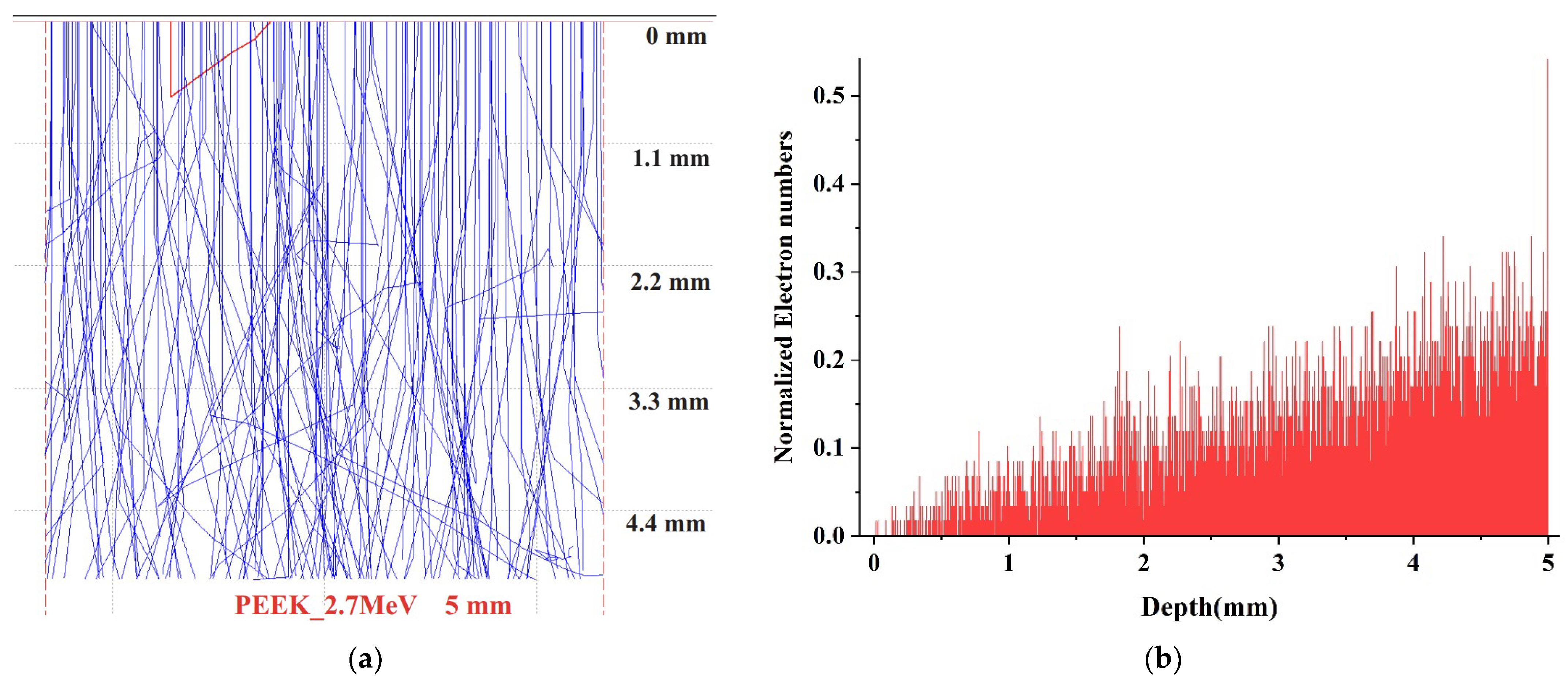
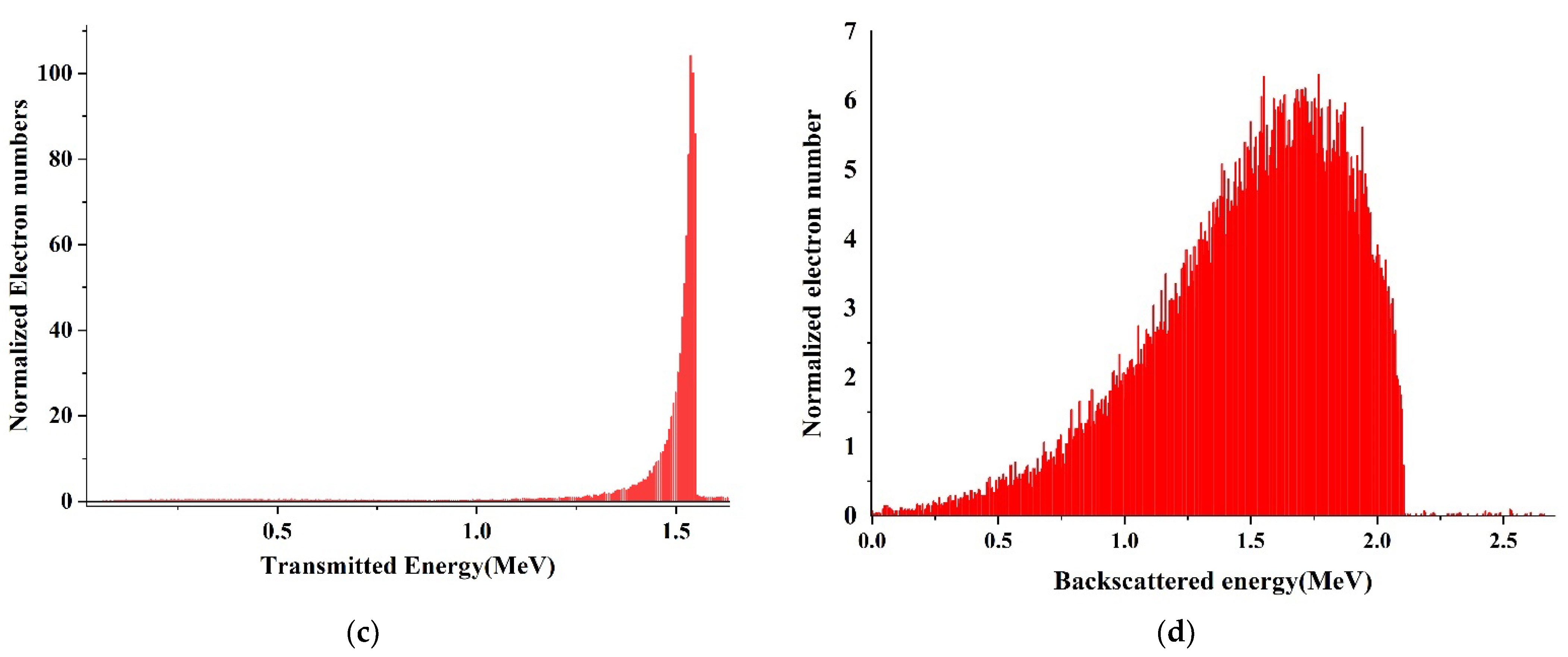
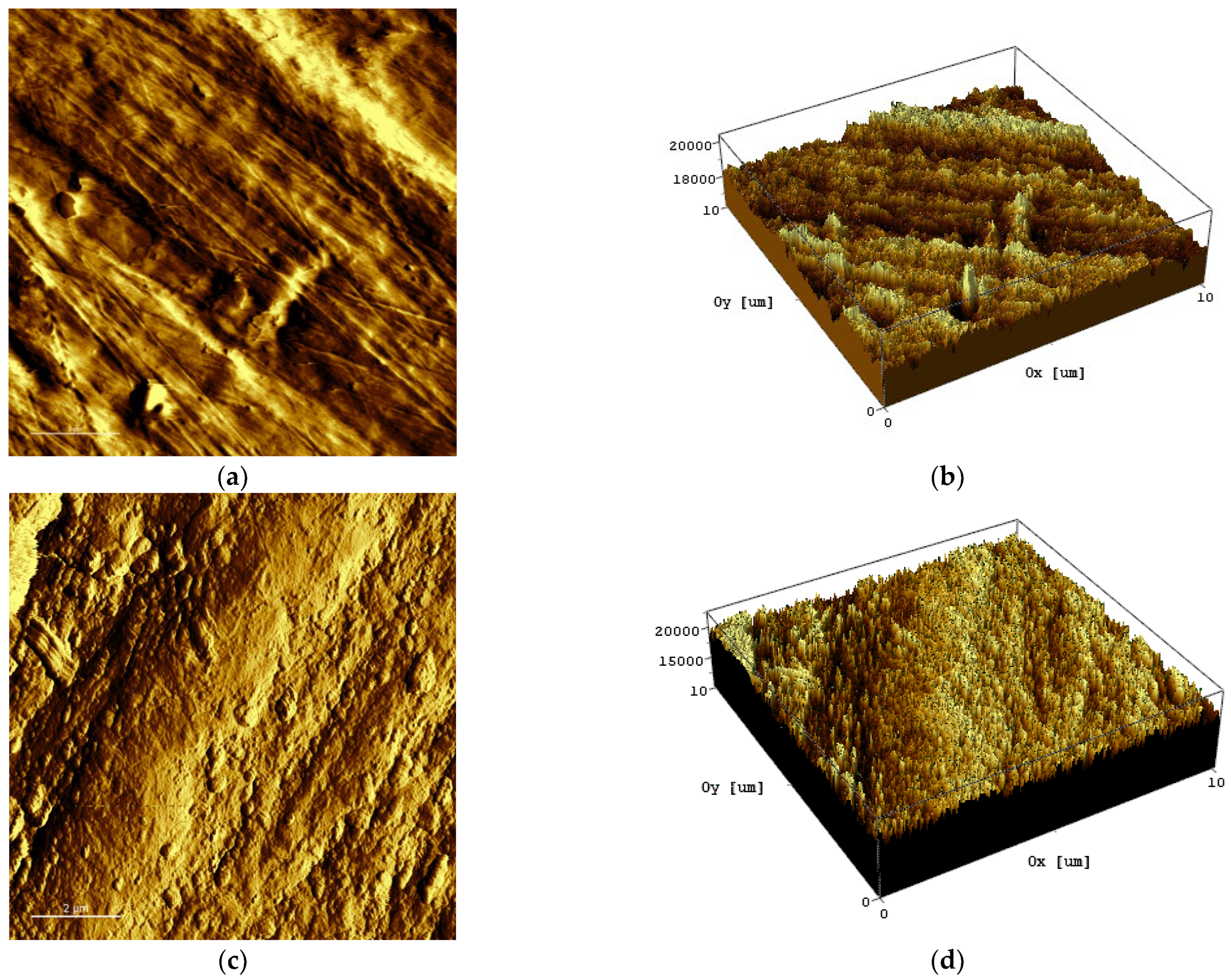
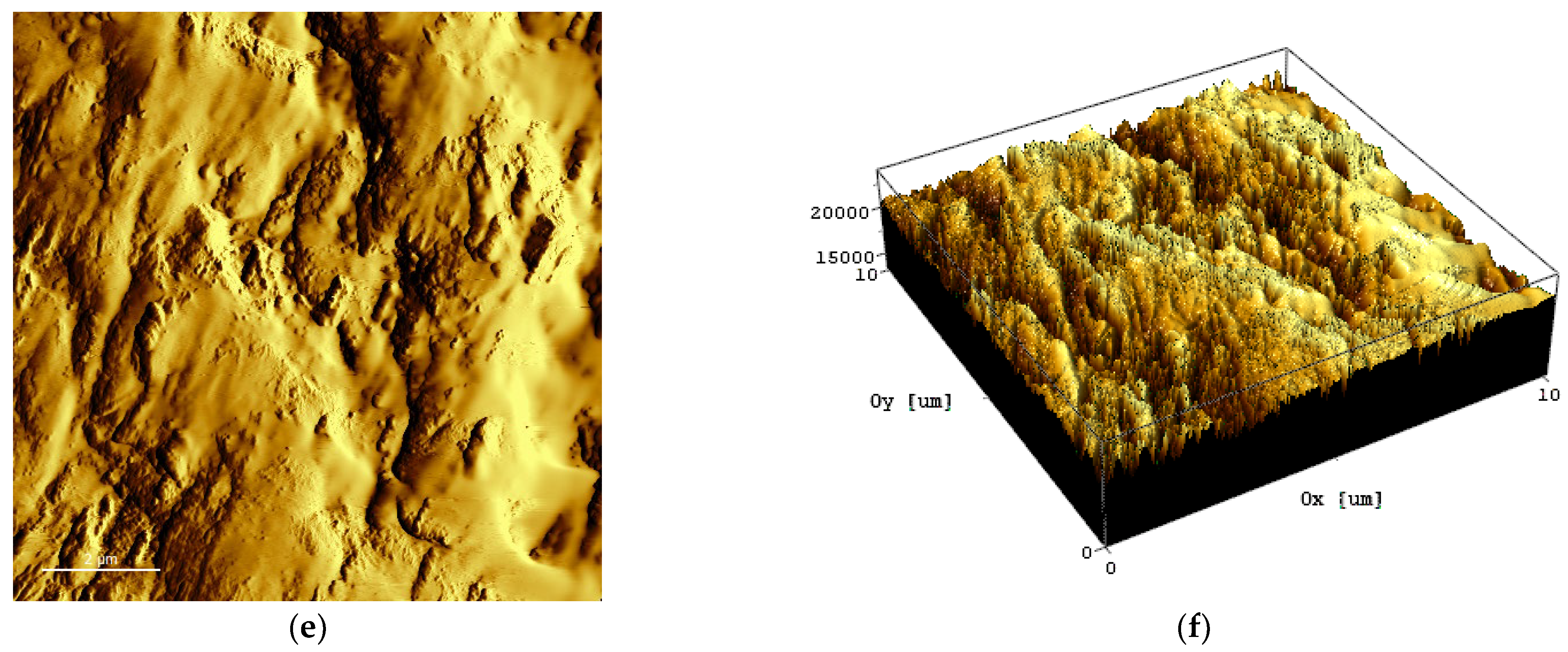
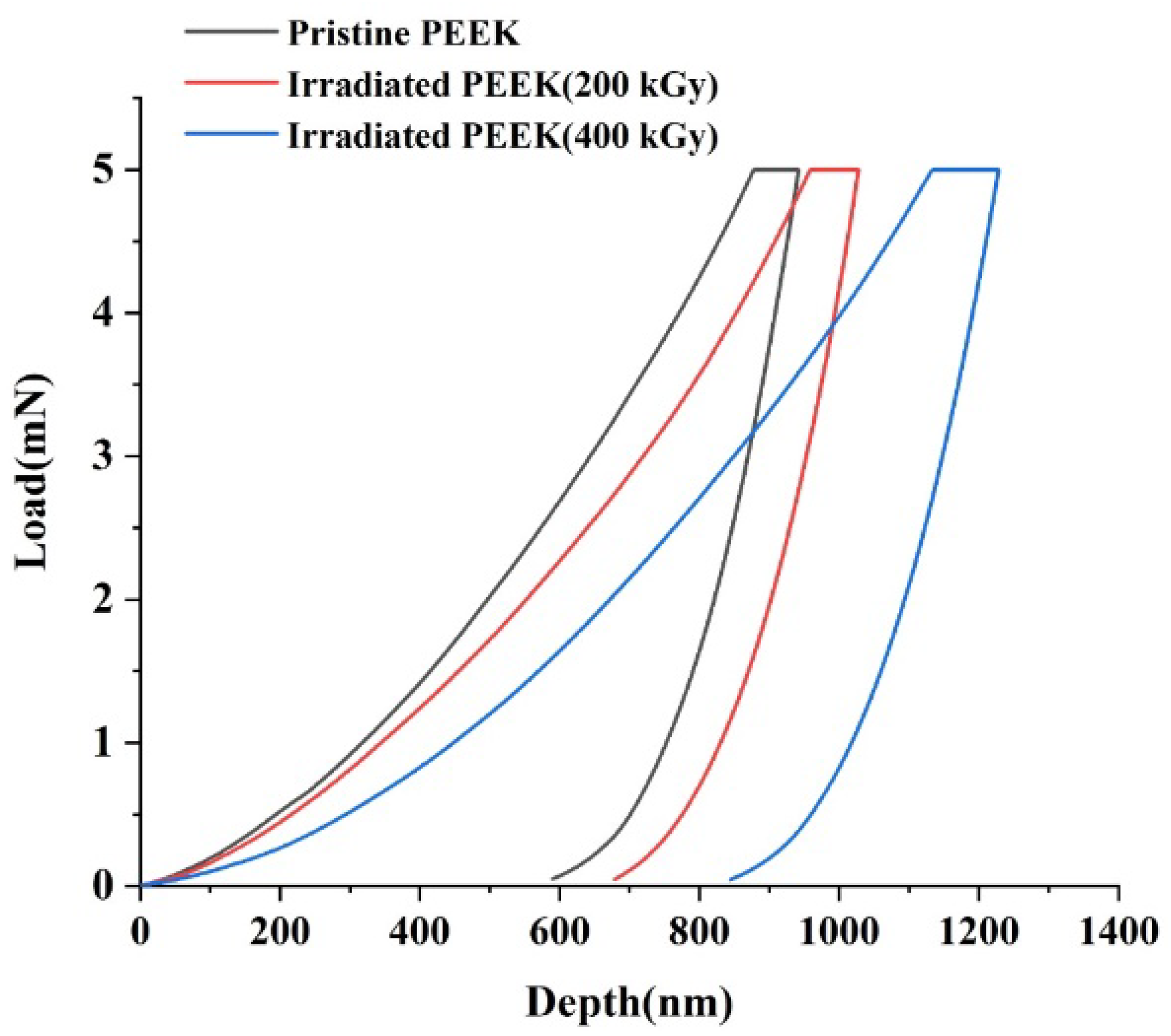
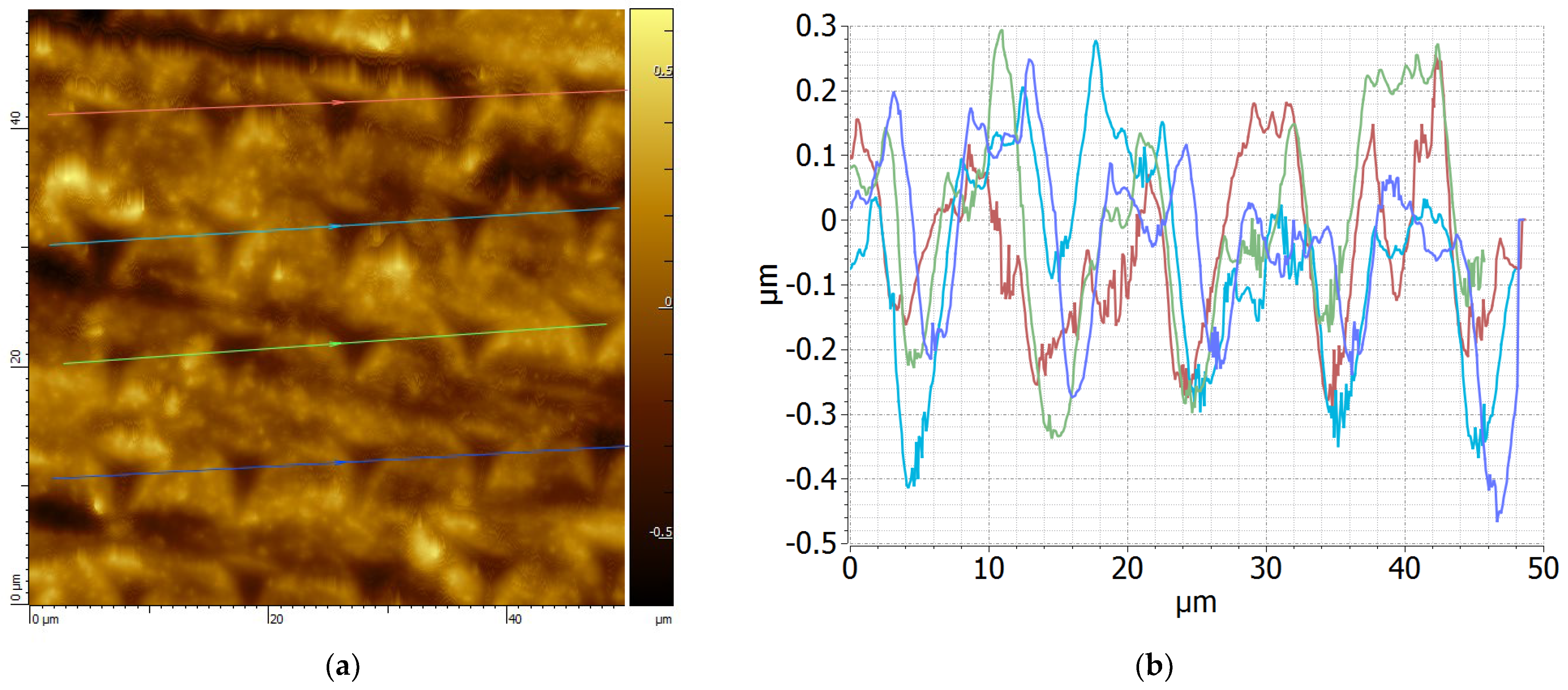
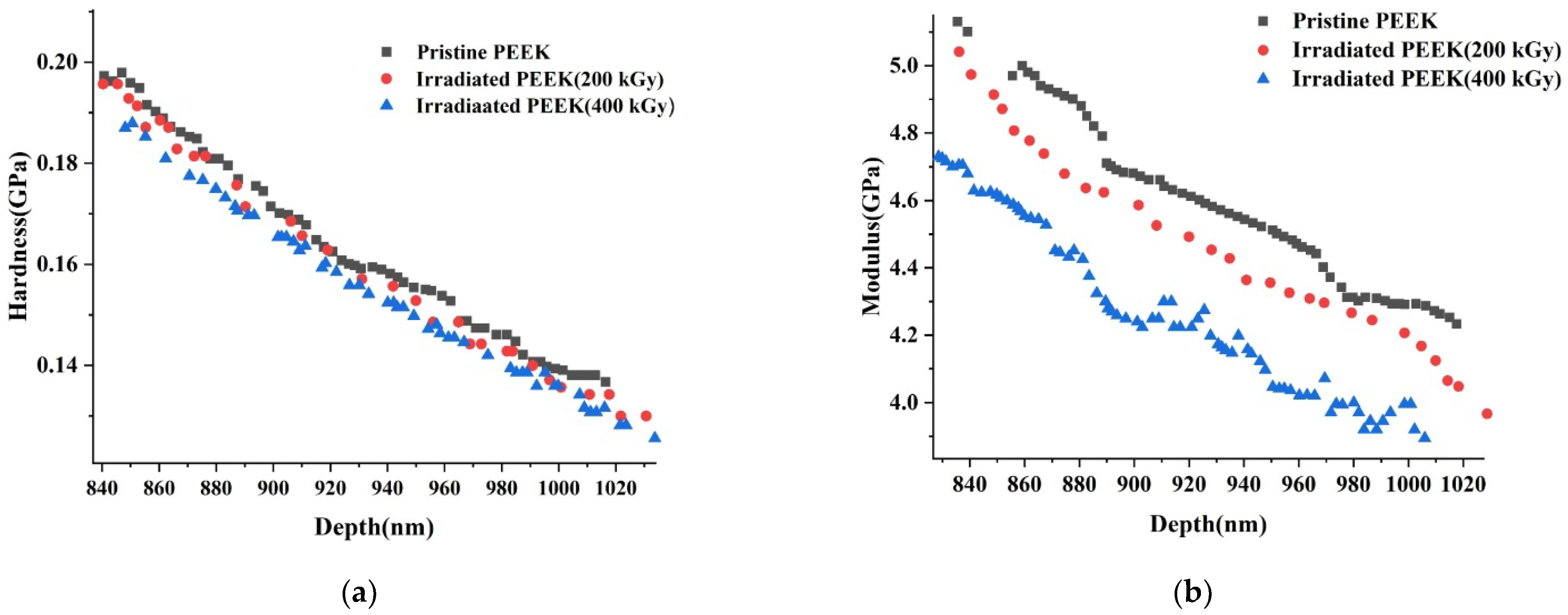
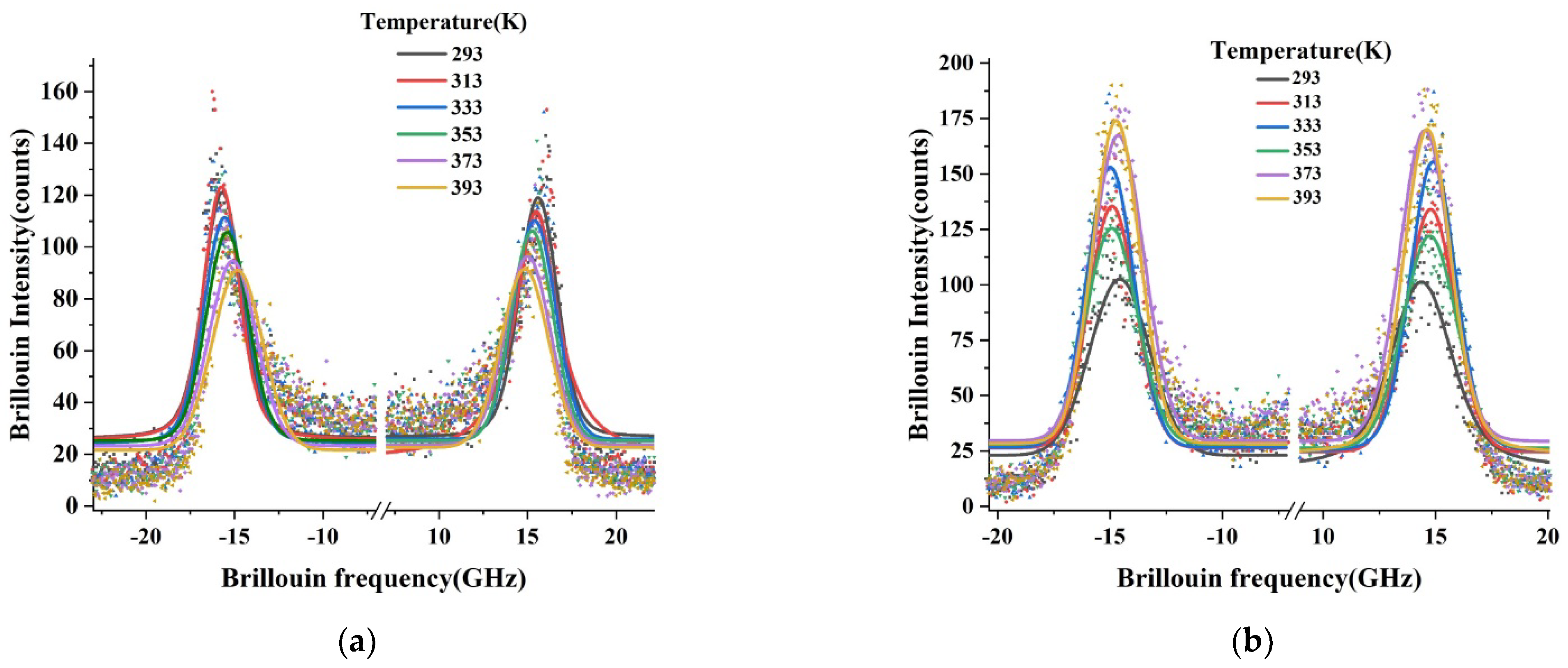
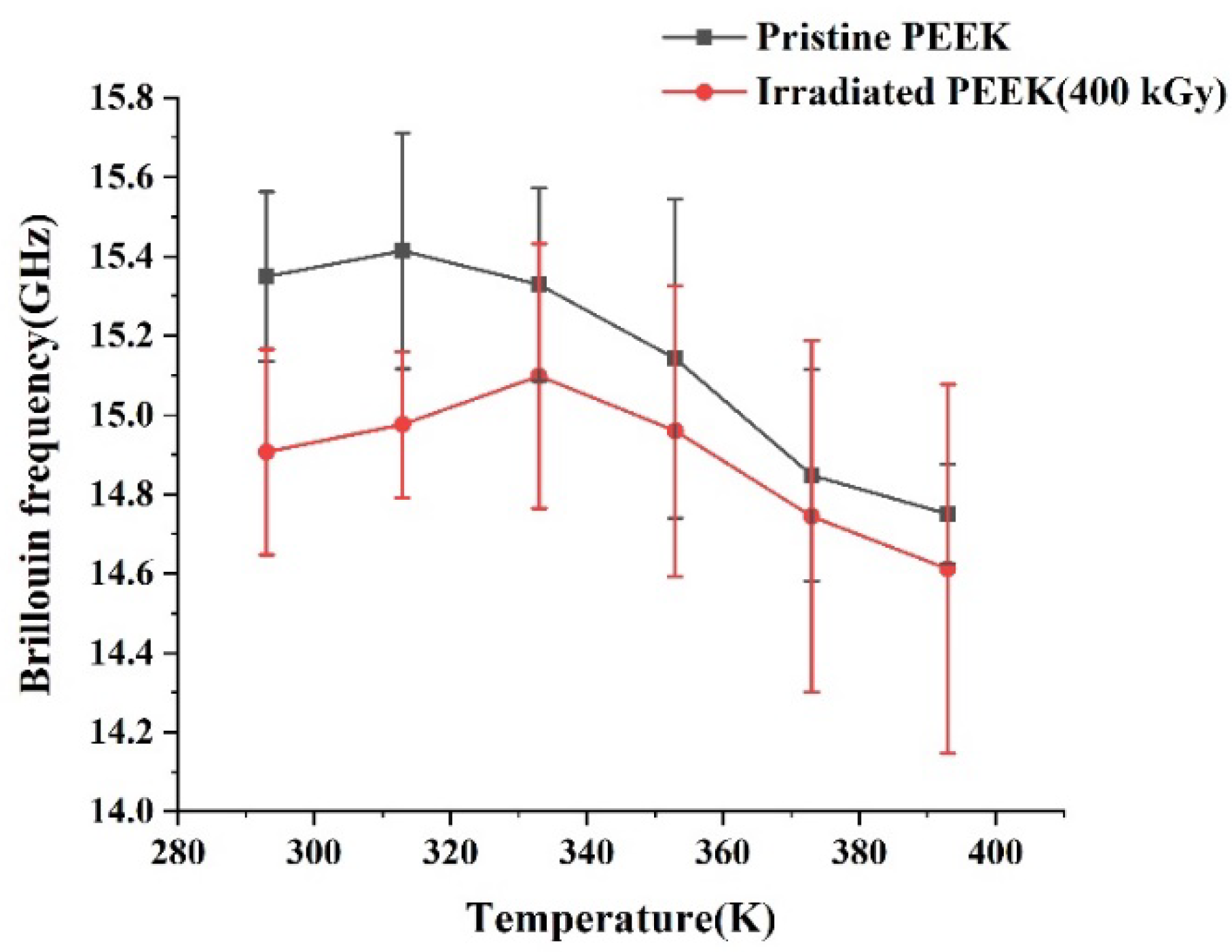
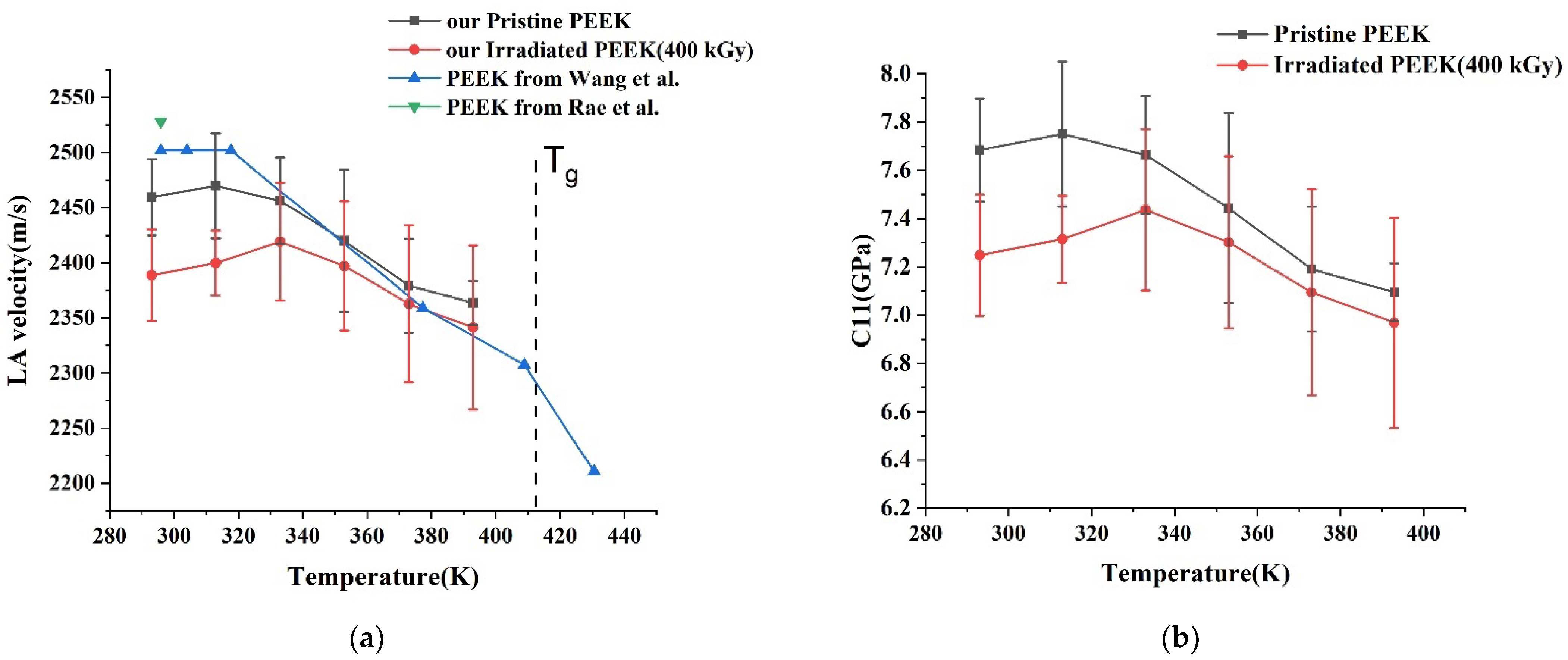
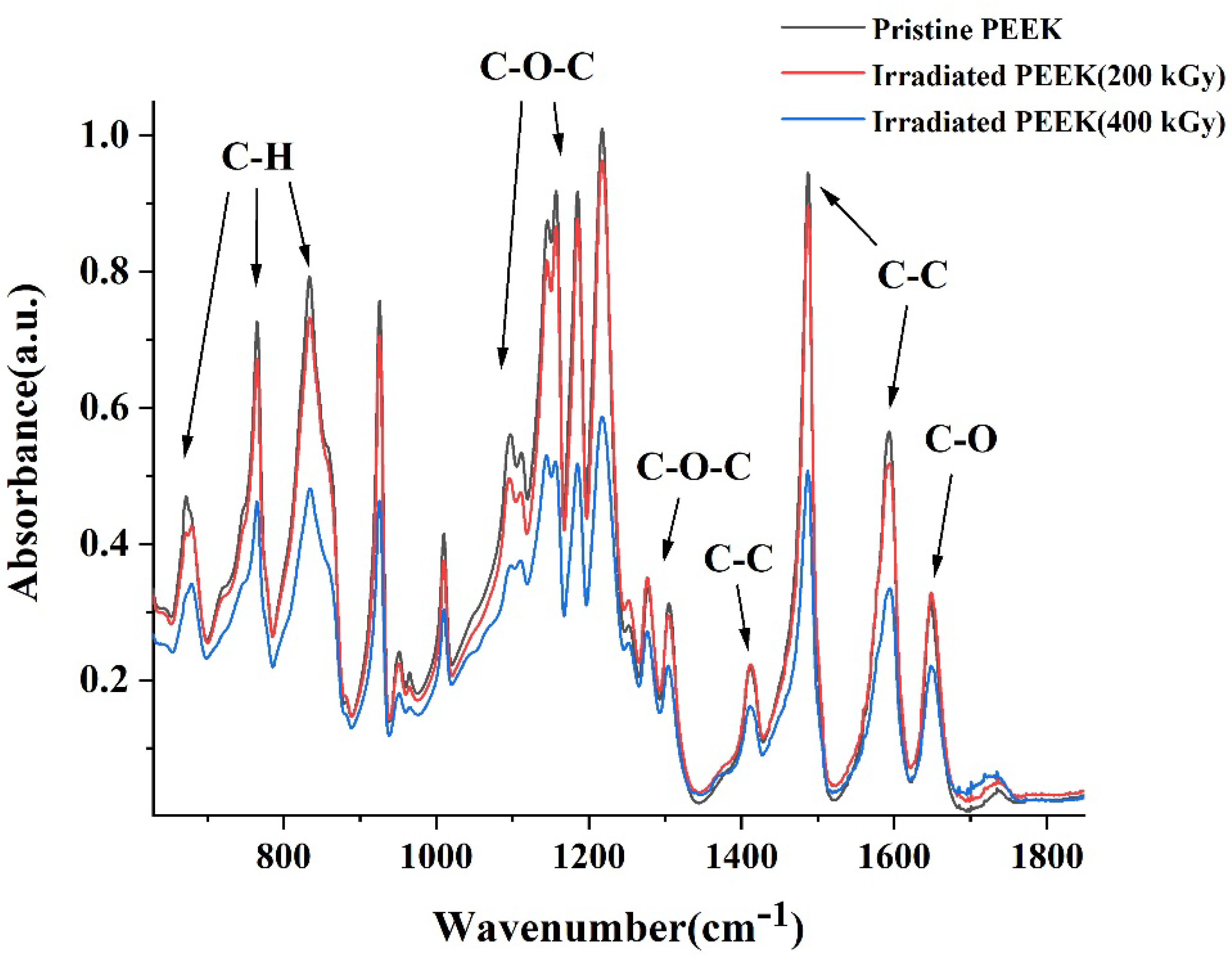
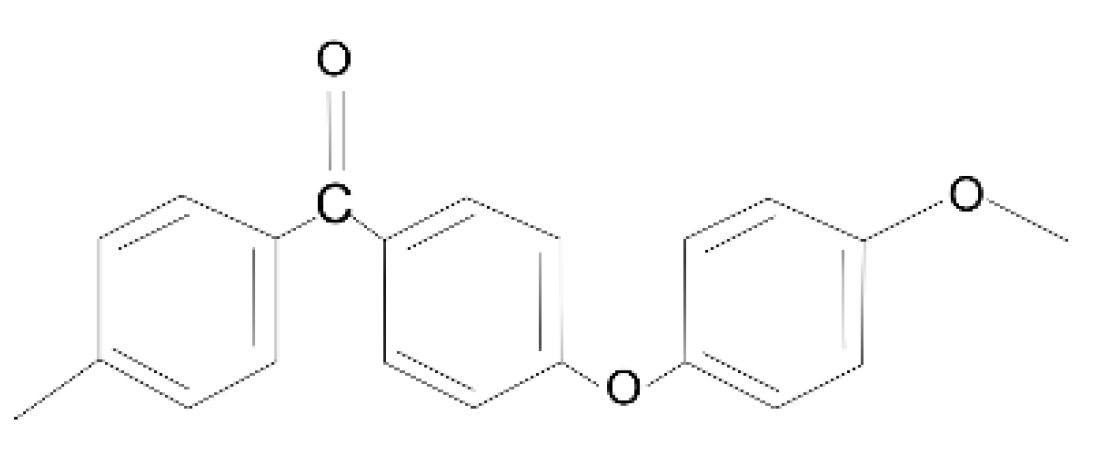
| PEEK Sample | Ra, [nm] | Rms, [nm] |
|---|---|---|
| Pristine | 265 | 339 |
| Irradiated, 200 kGy | 750 | 904 |
| Irradiated, 400 kGy | 665 | 826 |
| PEEK Sample | Hardness, [GPa] | Elastic Modulus, [GPa] |
|---|---|---|
| Pristine | 0.19 | 4.79 |
| Irradiated, 200 kGy | 0.18 | 4.72 |
| Irradiated, 400 kGy | 0.17 | 4.47 |
| Load, [mN] | Depth, [nm] | Hardness, [GPa] | Elastic Modulus, [GPa] | Reference |
|---|---|---|---|---|
| 5 | 800–1100 | 0.19 | 4.79 | Our PEEK |
| 0–1000 | 0.3 | 4.7 | [47] | |
| 0–5000 | 0.23 | 7.8 | [48] | |
| 1.7–5.2 | 0–1000 | 0.25 | 4.2 | [49] |
| 8 | 0–3500 | 0.35 | 6 | [50] |
| Measurement Techniques | Young’s Modulus, [GPa] |
|---|---|
| Nanoindentation | 4.79 |
| BLS | 4.5 |
Publisher’s Note: MDPI stays neutral with regard to jurisdictional claims in published maps and institutional affiliations. |
© 2022 by the authors. Licensee MDPI, Basel, Switzerland. This article is an open access article distributed under the terms and conditions of the Creative Commons Attribution (CC BY) license (https://creativecommons.org/licenses/by/4.0/).
Share and Cite
Almas, N.; Kurbanova, B.; Zhakiyev, N.; Rakhadilov, B.; Sagdoldina, Z.; Andybayeva, G.; Serik, N.; Alsar, Z.; Utegulov, Z.; Insepov, Z. Mechano-Chemical Properties of Electron Beam Irradiated Polyetheretherketone. Polymers 2022, 14, 3067. https://doi.org/10.3390/polym14153067
Almas N, Kurbanova B, Zhakiyev N, Rakhadilov B, Sagdoldina Z, Andybayeva G, Serik N, Alsar Z, Utegulov Z, Insepov Z. Mechano-Chemical Properties of Electron Beam Irradiated Polyetheretherketone. Polymers. 2022; 14(15):3067. https://doi.org/10.3390/polym14153067
Chicago/Turabian StyleAlmas, Nurlan, Bayan Kurbanova, Nurkhat Zhakiyev, Baurzhan Rakhadilov, Zhuldyz Sagdoldina, Gaukhar Andybayeva, Nurzhan Serik, Zhanna Alsar, Zhandos Utegulov, and Zinetula Insepov. 2022. "Mechano-Chemical Properties of Electron Beam Irradiated Polyetheretherketone" Polymers 14, no. 15: 3067. https://doi.org/10.3390/polym14153067
APA StyleAlmas, N., Kurbanova, B., Zhakiyev, N., Rakhadilov, B., Sagdoldina, Z., Andybayeva, G., Serik, N., Alsar, Z., Utegulov, Z., & Insepov, Z. (2022). Mechano-Chemical Properties of Electron Beam Irradiated Polyetheretherketone. Polymers, 14(15), 3067. https://doi.org/10.3390/polym14153067






_Insepov.png)


